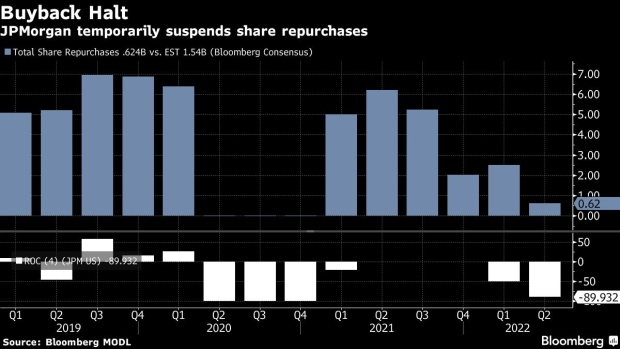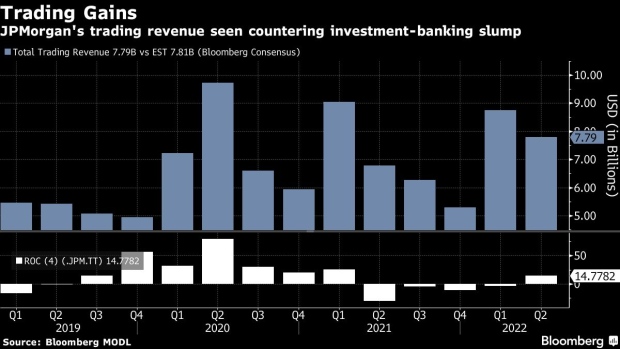Jul 14, 2022
JPMorgan halts share buybacks as earnings miss estimates
, Bloomberg News
JPMorgan halts share buybacks
JPMorgan Chase & Co. temporarily suspended share buybacks and reported second-quarter results that fell short of analysts’ estimates, driving the stock as much as 5.1 per cent lower.
The buyback pause is needed to quickly meet higher capital requirements and “allow us maximum flexibility to best serve our customers, clients and community through a broad range of economic environments,” Chief Executive Officer Jamie Dimon said in a statement Thursday.
The results offer the first look at how Wall Street fared in a tumultuous three months characterized by changing outlooks on prospects for the economy. Morgan Stanley also missed estimates as revenue from investment banking slumped 55 per cent, the company said Thursday. Dimon warned of an economic “hurricane” last month, citing the challenges the Federal Reserve faces as it tries to rein in inflation.
JPMorgan added US$428 million to the pile of money it set aside for potentially sour loans, reflecting “a modest deterioration in the economic outlook.” That marks a reversal from last year, when the firm’s results were padded by a US$3 billion reserve release.
While the US economy continues to grow -- with consumer spending and the job market both healthy -- geopolitical tension, high inflation, uncertainty over rate hikes and the impact of Russia’s invasion of Ukraine “are very likely to have negative consequences on the global economy sometime down the road,” Dimon said. “We are prepared for whatever happens and will continue to serve clients even in the toughest of times.”

Investment-banking fees declined 54 per cent, more than the 47 per cent drop analysts predicted, as dramatic market moves in the quarter stymied dealmaking. That division was also hurt by US$257 million of markdowns on held-for-sale positions in the bank’s so-called bridge book, according to the earnings statement.
June was a “particularly slow month” for the capital-markets business, Chief Financial Officer Jeremy Barnum said on a conference call with journalists.
Trading revenue jumped 15 per cent to US$7.8 billion, the New York-based company said, while analysts had expected a 17 per cent increase.
“Trading markets whipsawed with each release of economic data during the quarter as investors evaluated the Federal Reserve’s ability to curtail inflation with interest-rate hikes,” President Daniel Pinto wrote in a note to employees Thursday seen by Bloomberg News. Though results fell short of expectations, strength in currencies, emerging markets and equities drove the firm’s second-best second quarter ever for trading.

Shares of JPMorgan, which are down 33 per cent this year, declined 4.9 per cent to US$106.43 at 9:34 a.m. in New York, the steepest intraday drop in more than four months.
JPMorgan said regulators will require its common equity Tier 1 ratio to be 12.5 per cent by the first quarter of next year, due to a harsher stress-test result and a previously flagged increase to its buffer for systemic importance. That’s up from a minimum of 11.2 per cent at the end of June, and significantly higher than the 11.7 per cent requirement that the firm told investors just two months ago to expect for early 2023.
The buyback pause should allow the bank to get to 13.2 per cent by next March, comfortably clearing regulators’ bar. But that comes at the cost of handing back money to investors: JPMorgan had averaged about US$2.2 billion of buybacks a quarter over the past year, on top of US$3 billion a quarter of dividend payments.
The firm’s net income fell 28 per cent to US$8.6 billion, or US$2.76 a share. Analysts were predicting US$8.9 billion.
JPMorgan’s non-interest expenses rose 6 per cent to US$18.7 billion, lower than analysts were expecting. The firm’s costs have been a focal point for investors after executives said they expect an 8.6 per cent increase this year.
Net interest income, a key source of revenue for JPMorgan, rose 19 per cent in the second quarter on higher interest rates and loan growth. Analysts had expected a 16 per cent increase. The company said it expects NII of US$58 billion this year, the third such increase this year and higher than the US$56 billion it projected in May.



